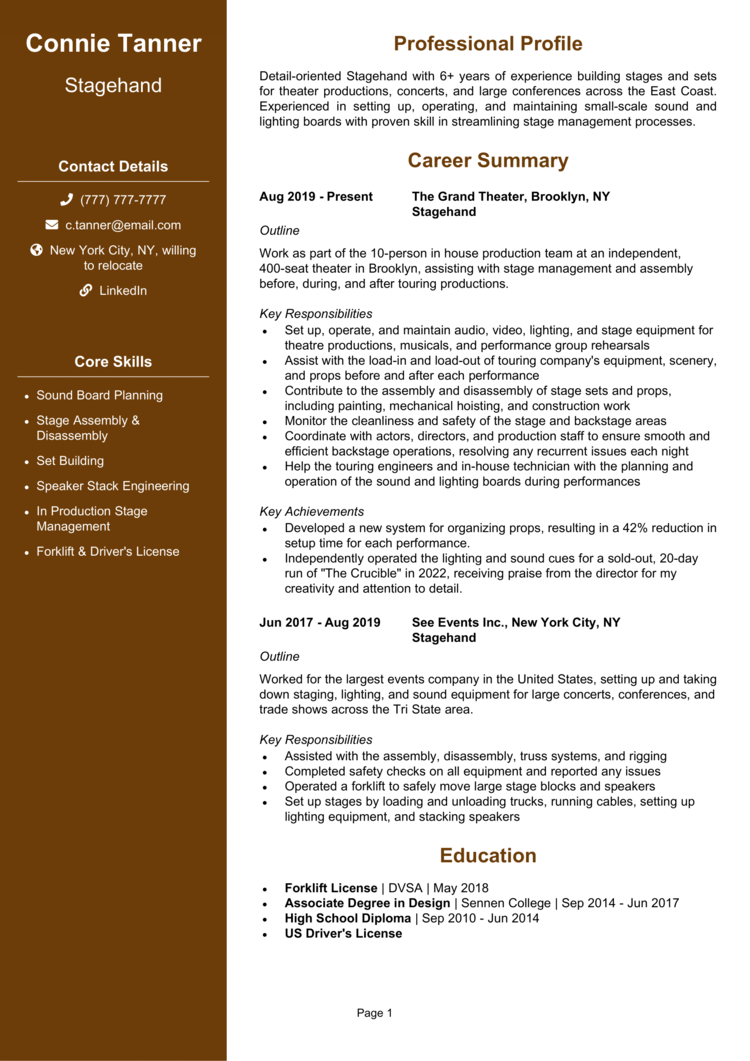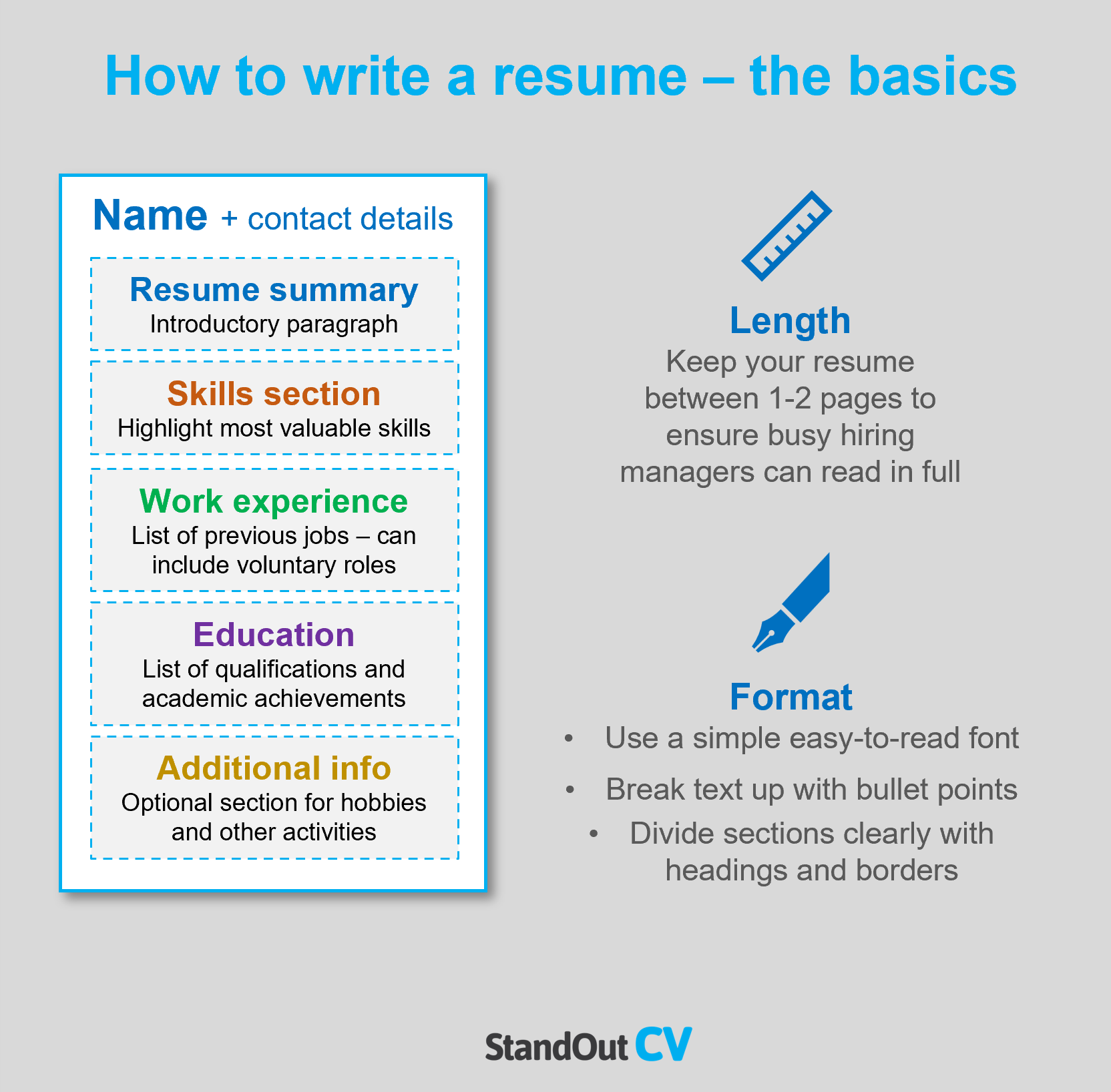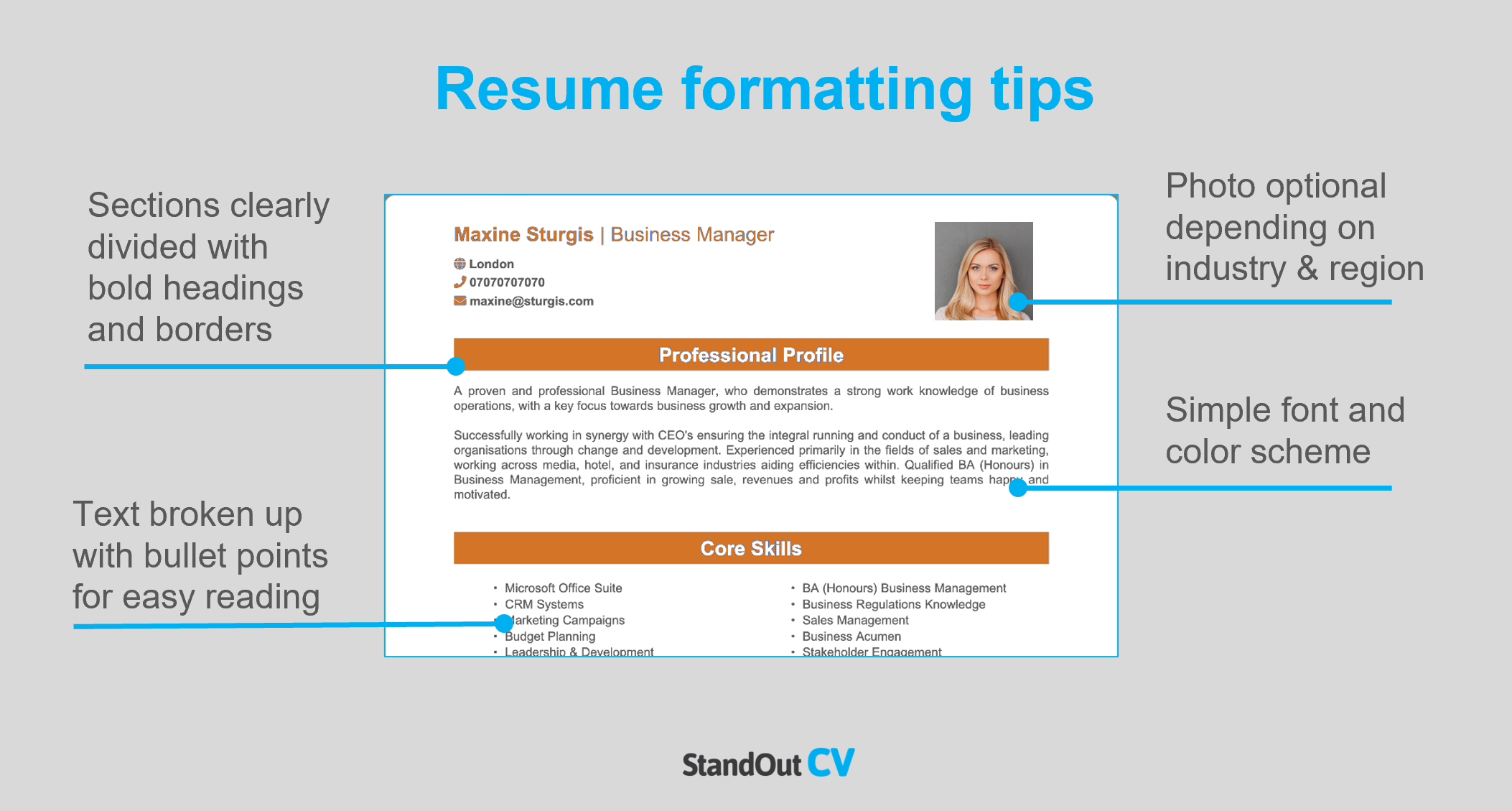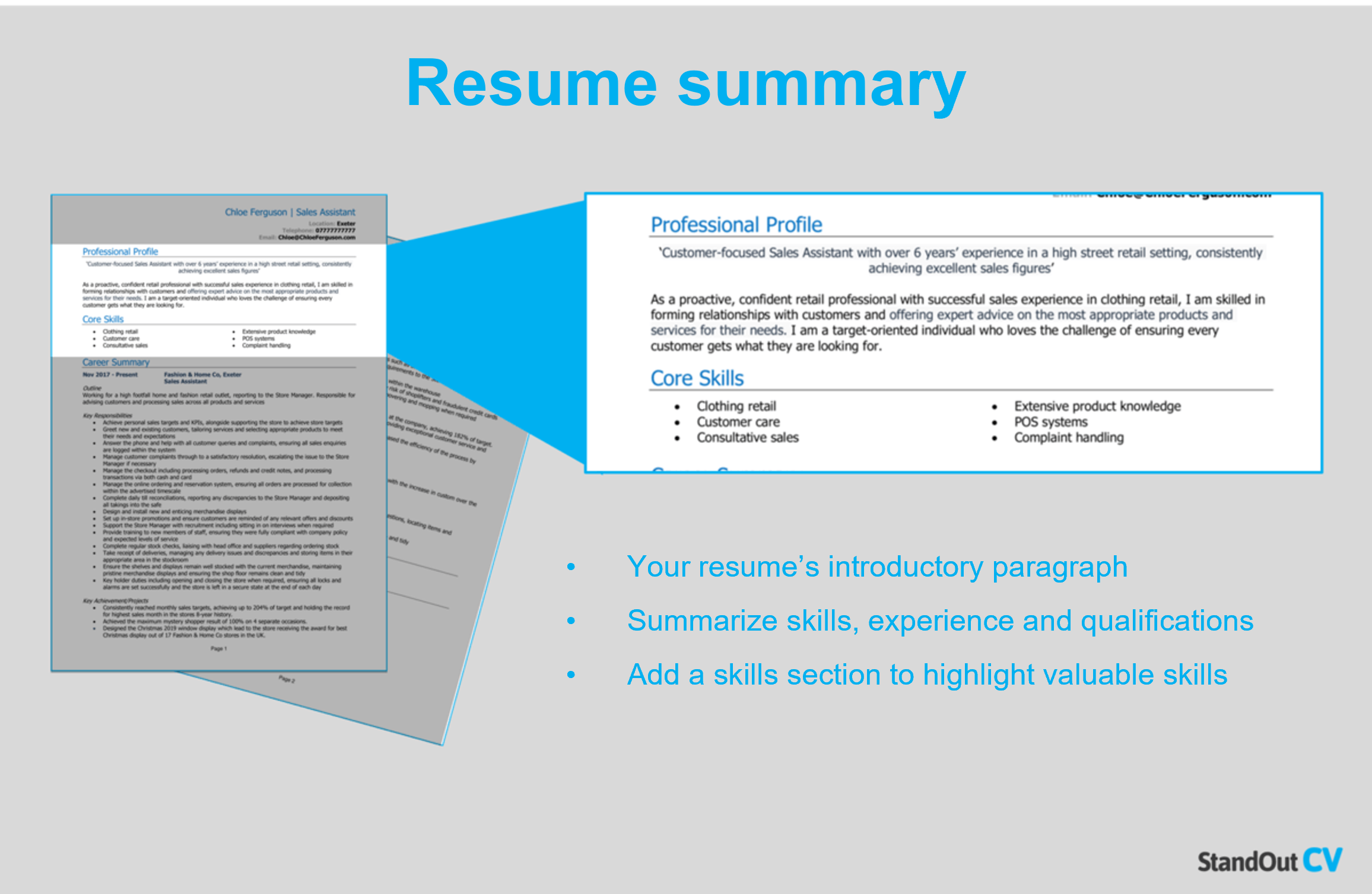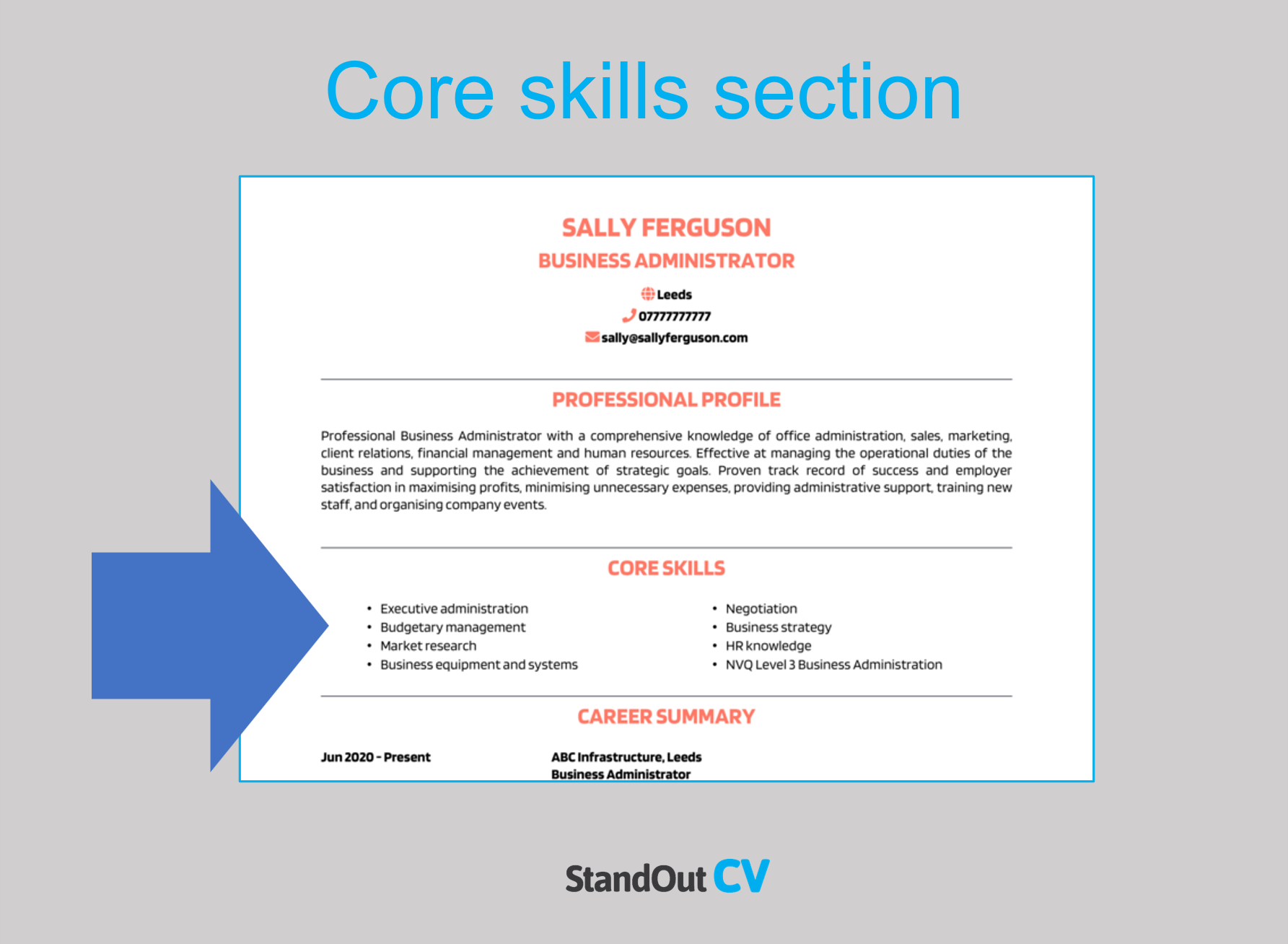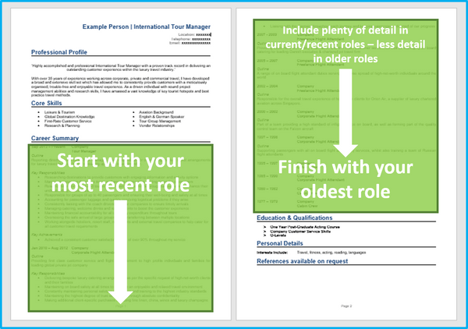You love theatre and bringing shows to life, but being on the stage isn’t for you – and that’s OK.
Why not put your creativity and organization skills to good use and land yourself the part of stagehand instead?
Let us help you reach for the stars with our step-by-step guide to writing an application, followed by our detailed stagehand resume example to inspire you.
Contents
|
Stagehand Resume Example
This example Stagehand resume provides you with a general idea of how your resume should look, and what information recruiters expect to see.
The rest of this guide will explain how to layout your resume and create each section effectively.

Stagehand resume layout and formatting
If you want to get noticed in the job market, you have to pay attention to the format and layout of your resume.
Essentially your resume needs to look highly polished, and provide hiring managers with an easy reading experience.
Use these resume formatting tips to get a head start on this.
Formatting your resume
- Length: Recruiters often see hundreds of resumes per day – so keep yours under 2 pages in length, if you want to ensure it gets read in full.
- Font & readability: Nobody likes to read huge unbroken paragraphs of text – and recruiters are no different. Break your resume text up with bullet points and use a clear simple font.
- Layout & Structure: A visually appealing resume is important, but don’t forget about functionality. To ensure a functional design, use bold headings and borders to organize the page into clear sections.
- Photos: While a photo is not usually necessary on your resume in the United States, it may be beneficial to include one in regions and industries where it is customary.
Quick tip: Achieving a professional look for your resume can be difficult and time-consuming. If you want to create an attractive resume quickly, try our quick-and-easy Resume Builder and use one of their eye-catching resume templates.
Resume layout
When you write your resume, include the sections below.
- Name and contact details – Pop these at the very top to ensure recruiters know how to contact you.
- Resume summary – An eye-catching paragraph which summarizes your most valuable attributes – placed near the top of your resume
- Skills section – A bullet pointed list of your most in-demand skills, enabling recruiters to see your suitability from a glance.
- Work experience – List some or all of your previous jobs in reverse chronological order – voluntary work and college placements can be included if you have no paid experience.
- Education – A summary of your professional training and academic qualifications.
- Additional info – An optional section for anything that may boost your application, such as relevant hobbies and interests
Here’s what to include in each part of your resume.
Contact Details
Keep your contact details short to save resume space and include the following.
- Name and profession title
- Cell phone number
- Location – Add your local area such as Silicon Valley or New York, unless you are looking for work in a different location
- Email address – Keep it professional and don’t use an old address that you thought was cool in high school, but now looks a bit embarrassing.
You can add a link to your LinkedIn profile if you have one – you do not need to include personal details like date of birth or marital status.
Stagehand Resume Summary
Grab the attention of recruiters right away by including a compelling summary at the top of your resume that summarizes your most valuable skills and experience.
This brief yet impactful section enables you to demonstrate why you’re the best candidate for the job and convince recruiters to keep reading.
How to create a resume summary that will excite recruiters:
- Keep it short: Aim for a short punchy paragraph of 4-7 lines. This is just enough info to showcase why you’d make the perfect hire, without going into excessive detail and overwhelming busy recruiters at such an early stage in the resume.
- Tailor to target jobs: By carefully reviewing the job description and incorporating as many relevant skills as possible, you can customize your resume to better match your target jobs.
- Avoid using cliches: You may be a “team player who always give 110%” but generic phrases don’t tell employers much about you in reality – stick to factual information.
Stagehand resume summary example
What to include in your Stagehand resume summary?
- Summary of your experience: Provide an overview of the type of work you have done in the past and the impact you have made at previous employers.
- Relevant skills: Include your skills which are hyper relevant to Stagehand jobs to instantly show your suitability.
- Qualifications: If your job requires any qualifications such as a professional course or a college degree, mention it briefly in your summary.
Quick tip: Choose from hundreds of pre-written summaries across all industries, and add one to your resume with one-click in our quick-and-easy Resume Builder. All written by recruitment experts and easily tailored to suit your unique skillset and style.
Core skills section
Sitting just underneath your resume summary, your core skills section gives recruiters 4-10 of your most in-demand skills in just a glance.
As Stagehand jobs may get hundreds of applications, this is a great way to stand out and quickly grab hiring managers’ attention.
It should be made up of 2-3 columns of bullet points and highlight attributes that are hyper-relevant to the jobs you are aiming for.
Best skills for your Stagehand resume
Rigging and stage equipment knowledge – Familiarity with the equipment and rigging used in stage productions.
Audiovisual equipment operation – Operating lighting, sound, and video equipment used in productions.
Stagecraft – Utilizing knowledge of the principles and techniques of staging, including set construction, props, and scenery.
Safety procedures – Utilizing knowledge of safety regulations and protocols in the entertainment industry to ensure a safe working environment.
Deadline management – Completing tasks within tight deadlines and adapting to last-minute changes in the production schedule.
Physical fitness – Lifting heavy equipment, climbing ladders, and working in physically demanding environments for extended periods.
Issue resolution – Identifying problems that may arise during a production and finding quick solutions to minimize disruptions.
Quick tip: Our quick-and-easy Resume Builder contains thousands of in-demand skills for every profession that can be added to your resume in seconds – saving you time and greatly improving your chances of landing job interviews and getting hired.

Work experience
Once you’ve hooked the hiring manager with your summary, you can really blow them away with you work experience.
List your previous jobs from newest to oldest to show the impact you made at each organization.
If you have years of experience, you can leave out some of the older jobs, and if you have little/no experience, you can bulk this section up with voluntary work and college placements.
Structuring your jobs
Your job description probably includes tons of information, so it’s vital to organize it well when writing about it on your resume.
Structure your jobs as like the example below to make skim-reading easy for recruiters and hiring managers.
Job outline
To provide context to your jobs, begin each job with a concise summary of the organization, your role within it, and the main objectives of your position.
Key responsibilities
The bulk of the role description should be comprised of bullet points that explain all of your duties in the job.
Keep the sentences short and simple to make them easy for recruiters to digest.
Key achievements
Round off each job by adding some impressive achievements you made in the role.
Anything you’ve done that has made a big impact on your employer will make a good impression, think; generating revenue, saving costs, or improving a product.
Quantify your achievements with number where possible e.g. “reduced call wait time by 10%”
Example job for Stagehand resume
Outline
Work as part of the 10-person in house production team at an independent, 400-seat theater in Brooklyn, assisting with stage management and assembly before, during, and after touring productions.
Key Responsibilities
- Set up, operate, and maintain audio, video, lighting, and stage equipment for theatre productions, musicals, and performance group rehearsals
- Assist with the load-in and load-out of touring company’s equipment, scenery, and props before and after each performance
- Contribute to the assembly and disassembly of stage sets and props, including painting, mechanical hoisting, and construction work
- Monitor the cleanliness and safety of the stage and backstage areas
Quick tip: Create impressive job descriptions easily in our quick-and-easy Resume Builder by adding pre-written job phrases for every industry and career stage.
Education section
Near the end of your resume add your education section
Experienced candidates should keep it brief and focus on professional qualifications – and junior candidates can include high school diplomas, college degrees etc.
Additional information
At the end of your resume, you can add any extra information that might be relevant to the jobs you are applying for.
This could be hobbies, interests, publications, clubs or memberships.
This section is optional and doesn’t need to be added if you have nothing more relevant to add.

Writing your own winning Stagehand resume
A winning Stagehand resume should look great, read well, and sell your skillset to hiring managers.
If you follow the steps above, you should be able to bag yourself a top job in no time.
Good luck with your job search!
